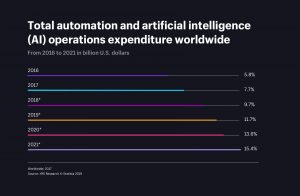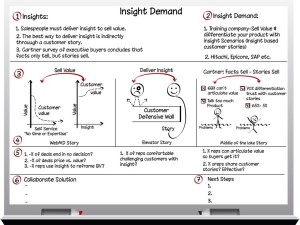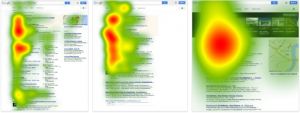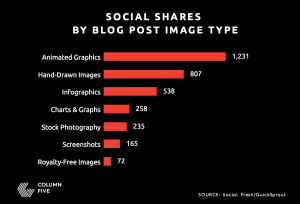AI (Artificial Intelligence) is on the rise, finding its way into every nook and cranny, making everything along the way easier for everybody who’s implementing it, but what is AI?
We may all know AI as primarily a source of evil thanks to films like The Terminator and IRobot, but the reality is, that it’s much less terrifying. AI uses principles of deep learning, machine learning, and predictive analytics while interacting with big data (more on this in a moment) to find adaptive solutions.
Still sounds scary right? But don’t worry, I’ll be breaking these concepts down into fishes and ties. Before you know it you’ll be talking about AI like you’d known it for years.
What is AI?
Let’s start by introducing you to one of the most basic rundowns for what each core component does: Machine learning is automated learning, while deep learning is automated understanding, predictive analytics looks for patterns in data to predict the future and big data is a massive collection of data that’s just sitting there doing nothing until interacted with. Now let’s break it down.
Machine learning is the tie in the suit. Without it, you’re left with a blank empty space, and with it, you have a fully functioning seriously sophisticated look. Why a tie?
When you start out buying ties you’re not too sure why you’re doing it, so you buy a bright blue one with yellow rubber ducks – screaming your presence out to the world. You’ll probably soon realise you’re not taken seriously. So what is a serious tie? The more ties we look at, the more we grow to realise what colours we should wear on different occasions to be taken seriously. We grow, adapt and wear what’s right for the occasion. Machine learning is this growing and adapting. It’s a heavily analytical method of handling statistics and data to produce algorithms (mathematical solutions) that can evolve to recognise what’s needed of itself to succeed. And much like a tie, machine learning is the glue necessary to hold the pieces of the AI suit together.
Deep learning, on the other hand, has a little bit more going on behind the scenes. As you select your tie you learn that it’s not really acceptable to wear a serious tie with your bright blue banana print suit. You suddenly realise that you had the right idea, but you missed out the rest.
You bounce around ideas of what suits you want, what suits would be suitable. You probably bounce around from store to store finding what styles are available and how well it works in regards to your tie and your current situation. Bounce is a very important keyword here as not only are you bouncing from store to store but your brain is bouncing information trying to process everything and dismissing unimportant details and prioritising; homing in on what would be best.
Information basically bounces around in a dot to dot-like fashion around maps of neural networks. Neural networks work like your brain and were actually inspired by animal brain biology. This bouncing eventually results in drawing a conclusion of your overall look and a final result. It is very similar to machine learning, but it builds on the core concept and allows for an overall picture to be drawn with a much deeper understanding.
Predictive analytics is just making sure that the suit you purchase will find use at a later date. Are you going to use this suit again? The tie won’t work with all the suits out there, do you need a new tie? Predictive analytics uses past and present data and throws it through a bunch of fancy statistical algorithms that gives you the answers to life’s difficult questions. When predictive analytics is combined with machine learning algorithms to predict the probability of future outcomes; it’s usually got a pretty high accuracy.
Big data is basically what it says on the box, a huge collective of data. In our current metaphor; every component of every suit in the world (including shoelaces). The only problem is, with so much data being collected every single day, we as humans, can’t interact with it at the same pace it’s being collected. This is where AI comes into play. AI can adaptively collect data on the fly and in the case of e-commerce, it will save you hours of time in finding out who your core market is, what your customers are buying, and what you should be selling to adapt to your market. Not only that but it’ll help your customers get the products they want.
How does this help me sell more online?
Before we get onto talking about the big league players in the e-commerce AI world, we should probably discuss precisely how all of this helps your shop.
Let’s start with a fish called Dave, a little fish that’s never used a computer before – a blank slate with no real clue on what’s what. So Dave types into the computer (because this fish has hands) ‘shoes’ (and also feet.) The first key is struck and it begins. How fast was the query typed? Did Dave hit enter or move the mouse and click submit? Is the mouse being used at all? How many times is Dave hitting backspace? What is Dave’s words per minute?
All of this, while meaningless for many, can be used and analysed to produce the right result for Dave. But how? Inputs are taken – no matter how meaningless – and passed through layer upon layer of neural networks, each network assessing the input and assigning weight (much like weight in an argument) based on how the simplest of interactions are related.
The relations are compared with one another as they fly through the neural network, with previous or past data from other users also adding or removing weight to the argument before finally producing a conclusive result for Dave, while also forming a map for how this particular fish functions online. The result? Flippers.
After processing, this data collection results in not only helping your customers find what they want but also tells you how your customers use your online shop, which is huge. What they navigate to, how they get there and what products they’re looking at. You can then use this information to effectively recreate marketing strategies, focus branding/ products, and understand where you need to put items to maximise on shop-front efficiency.
How did it all begin?
Back before the evolution of UI/UX (User Interface/User Experience) development all of the original big e-commerce players were huge on trying to make their shop the best, the slickest and the easiest.
Of course, this was achieved quite simply by revolutionising the one core ingredient to a massive online shop – the search bar. Keywords have always been commonplace among searching for items online, and it was only smart to start there. By making the search bar keyword-friendly (also known as keyword easy) customers were finding relevant products based on their search queries rather than trawling through pages upon pages of products trying to find exactly what they were after.
Unfortunately, a lot of sellers and store owners caught onto this and as time went by-products on large e-commerce sites and search engines started to fill out with keywords that for the most part weren’t even relevant to the product itself. From here technology had to evolve, adapting to other user inputs that brought relevance to product searches. It was found that implicit data (clicks, likes, shares, views) were greatly useful in creating customer profiles to advertise what customers wanted to buy and what products best suited them. The e-commerce world is still evolving in this game, but it’s getting better as time moves on.
How does this benefit me?
With the ever-growing world of e-commerce it is becoming increasingly difficult to start up an online store, increasingly difficult to find the exact pair of shoes you’re after (poor Dave), and increasingly difficult to get through to your targeted audience.
With the growing volumes of customers, shops, and products, AI-driven analytics are becoming all the more essential in the evolution of e-commerce. While all of this happens in the background, AI predicts what customers are looking for based on their interactions with other products in their shopping history. Thanks to this core benefit, AI can aid in reducing high marketing spends, high operation costs, customer attrition, business leakages.
How can I get started?
There are many major players in the big league of common-place e-commerce AI. Google, Facebook, and Amazon to name a few. The two we’re going to focus on however are Google, and Facebook, starting with Facebook.
Facebook Pixel is now a must-have on all e-commerce stores. It’s a small slither of code that is so ridiculously powerful it can aid your shop’s marketing power massively. Talking big talk I know, but it’s true. Facebook pixel is at its most powerful in the early days as it amasses a large collection of data for your shop, the earlier the better, so if you haven’t got it on your shop right now and it’s a busy time of day, I’d advise getting it up and running as soon as possible.
It collects data that helps you track conversions from Facebook ads, optimise the ads you have in place, build target audiences for future ad campaigns, and re-target those who have had a look at your website, but decided against purchasing anything this time.
If you have this pixel installed it can help you rebuild your target audience based on the similarities of likes, interests, and demographics of people who are already interacting with your shop. It’s constantly collecting data and combining it with existing data while shuffling it through Facebook’s AI before chugging out an amazing result. There are so many successful case studies of those currently using the pixel so make sure you’re joining in, as it can save you a tonne of money.
Google. Okay, Google itself is not an AI… it’s a search engine, ya got me! But it’s an important one at that.
In fact, one of the best ways to get your website found is through this search engine. You might be thinking, we’re talking about AI right? When in reality the Google search engine is one of the largest AI’s in the world, constantly adapting through basic Artificial Intelligence principles to find the best results for its users. Getting Google Search Console and Google Analytics on your shop as soon as possible is going to bring so much more to your store.
What might the future of e-commerce look like?
With the rise of Amazon’s Alexa, Google’s Assistant, and Apple’s Siri we are entering the age of voice-assisted shopping. It is already speeding up the process of purchasing repeat items, small and simple items, and impulse items. With the advancement of Artificial Intelligence and moving in the direction we are going, I wouldn’t be surprised that within a decade we’ll be taking pictures of sofas in our friends’ homes and instantly being taken to a sellers shop with that same couch in stock.
Digital & Social Articles on Business 2 Community
(36)







